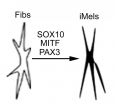INFORMATION:
Find out more by reading the article, "Male Ebola Survivors: Do not forget to use a condom!" in Reproductive Sciences. For an embargoed copy of the full article, please email Camille.Gamboa@sagepub.com.
Reproductive Sciences (RS) is a peer-reviewed, monthly journal publishing original research and reviews in obstetrics and gynecology. RS is multi-disciplinary and includes research in basic reproductive biology and medicine, maternal-fetal medicine, obstetrics, gynecology, reproductive endocrinology, urogynecology, fertility/infertility, embryology, gynecologic/reproductive oncology, developmental biology, stem cell research, molecular/cellular biology and other related fields. http://rsx.sagepub.com/
SAGE is a leading international publisher of journals, books, and electronic media for academic, educational, and professional markets. Since 1965, SAGE has helped inform and educate a global community of scholars, practitioners, researchers, and students spanning a wide range of subject areas including business, humanities, social sciences, and science, technology, and medicine. An independent company, SAGE has principal offices in Los Angeles, London, New Delhi, Singapore and Washington DC. http://www.sagepublications.com
Men in recovery from Ebola should wear condoms for at least 3 months
2014-12-16
(Press-News.org) Los Angeles, CA (November 16, 2014) A new article reports that despite a clear lack of research on male survivors of Ebola, the current recommended practice of waiting at least three months after recovery to have unprotected sex should be upheld. This study was published today in Reproductive Sciences, a SAGE journal.
"Our exercise demonstrated that the current recommendations to prevent the sexual spread of Ebola are based on one mere observation," the researchers wrote. "Despite the evident need to conduct more research, for now, health care professionals should strongly recommend sexual abstinence or condom-protected encounters for at least three months."
Drs. Walter Cardona-Maya, Paula Velilla Hernandez, and Daniel Henao studied research from 1977 to 2007 on men in the convalescent phase of the Ebola virus (i.e. symptoms were fading and they were in recovery). They found only four studies that report male survivors of Ebola who donated convalescent semen. For these men, the virus persisted in their semen for an average of 66.6 days, and in one case, it persisted for 91 days.
The researchers continued, "The current Ebola Virus Disease outbreak is the longest and largest we have ever seen. Nonetheless, our results clearly demonstrate how much we ignore about it. Larger studies are needed to establish the social, clinical and biological determinants of this neglected disease. "
ELSE PRESS RELEASES FROM THIS DATE:
New technology directly reprograms skin fibroblasts for a new role
2014-12-16
PHILADELPHIA - As the main component of connective tissue in the body, fibroblasts are the most common type of cell. Taking advantage of that ready availability, scientists from the Perelman School of Medicine at the University of Pennsylvania, the Wistar Institute, Boston University School of Medicine, and New Jersey Institute of Technology have discovered a way to repurpose fibroblasts into functional melanocytes, the body's pigment-producing cells. The technique has immediate and important implications for developing new cell-based treatments for skin diseases such as ...
Top blood transfusion-related complication more common than previously reported
2014-12-16
Two studies published in the January issue of Anesthesiology, the official medical journal of the American Society of Anesthesiologists® (ASA®), shed new light on the prevalence of transfusion-related acute lung injury (TRALI) and transfusion-associated circulatory overload (TACO), the number one and two leading causes of blood transfusion-related deaths in the United States. According to researchers, postoperative TRALI is significantly underreported and more common than previously thought, with an overall rate of 1.4 percent. While the rate of TACO was found ...
Targeting inflammatory pathway reduces Alzheimer's disease in mice
2014-12-16
Alzheimer's disease (AD) is the most common form of dementia and is characterized by the formation of β-amyloid plaques throughout the brain. Proteins known as chemokines regulate inflammation and the immune response. In both patients with AD and mouse AD models, the chemokine CXCL10 is found in high concentrations in the brain and may contribute to AD. A new study in the Journal of Clinical Investigation indicates that activation of the CXCL10 receptor, CXCR3, contributes to AD pathology. Using a murine model of AD, Michael Heneka and colleagues at the University ...
Microbial-induced pathway promotes nonalcoholic fatty liver disease
2014-12-16
Nonalcoholic fatty liver disease (NAFLD) is the most common liver disorder and affects approximately 1 billion people worldwide. It is not clear how this disease develops, but recent studies suggest that the bacterial population in the gut influences NAFLD. A new study in the Journal of Clinical Investigation provides a link between molecular signaling pathways in the gut, the intestinal microbiome, and development of NAFLD. Frank Gonzalez and colleagues at the National Cancer Institute found that disruption of the gut microflora prevented development of NAFLD in mice fed ...
How to treat Ebola during pregnancy
2014-12-15
A pregnant woman in Africa who has contracted Ebola is likely to suffer with a spontaneous abortion, pregnancy-related hemorrhage, or the death of her newborn. Although the risk of caring for a pregnant woman with Ebola in the United States may be rare, the Association of Women's Health, Obstetric and Neonatal Nurses (AWHONN) has published a practice brief in its Journal of Obstetric, Gynecologic, & Neonatal Nursing to guide nursing care for pregnant women and newborns.
"Nurses play a vital role in caring for patients with Ebola," said Dr. Debra Bingham, who is Vice President ...
Shame on us
2014-12-15
Emotions are complicated and never more so than in the realm of the scientific, where commonly accepted definitions are lacking.
In a paper published in the journal Qualitative Inquiry, UC Santa Barbara's Thomas Scheff examines the basic emotions of grief, fear/anxiety, anger, shame and pride as they appear in scientific literature in an attempt to take a first step in defining them. "Emotion terms, especially in English, are wildly ambiguous," Scheff writes in the paper's introduction.
An emeritus professor of sociology at UCSB, Scheff set out to explore why the language ...
Herceptin found to improve long-term survival of HER2-positive breast cancer patients
2014-12-15
VCU Massey Cancer Center physician-researcher Charles E. Geyer, Jr., M.D., was the National Protocol Officer for one component of a large national study involving two National Cancer Institute (NCI)-supported clinical trials that demonstrated that trastuzumab significantly improves the long-term survival of HER-2 positive breast cancer patients. The combined study was designed to determine the long-term safety and efficacy of the drug trastuzumab, which is commonly known as Herceptin and is primarily used alongside chemotherapy to treat HER2-positive breast cancer. The ...
Switching to vehicles powered by electricity from renewables could save lives
2014-12-15
Driving vehicles that use electricity from renewable energy instead of gasoline could reduce the resulting deaths due to air pollution by 70 percent. This finding comes from a new life cycle analysis of conventional and alternative vehicles and their air pollution-related public health impacts, published Monday, Dec. 15, 2014, in the Proceedings of the National Academy of Sciences.
The study also shows that switching to vehicles powered by electricity made using natural gas yields large health benefits. Conversely, vehicles running on corn ethanol or vehicles powered ...
Non-Gluten proteins identified as targets of immune response to wheat in celiac disease
2014-12-15
NEW YORK, NY (December 15, 2014)--Researchers at Columbia University Medical Center have found that, in addition to gluten, the immune systems of patients with celiac disease react to specific types of non-gluten protein in wheat. The results were reported online in the Journal of Proteome Research.
Celiac disease, an autoimmune disorder that affects about 1 percent of the U.S. population, is triggered by the ingestion of wheat and related cereals in genetically susceptible individuals. The immune response results in inflammation and tissue damage in the small intestine, ...
Hidden movements of Greenland Ice Sheet, runoff revealed
2014-12-15
VIDEO:
This animation (from March 2014) portrays the changes occurring in the surface elevation of the Greenland Ice Sheet since 2003 in three drainage areas: the southeast, the northeast and the...
Click here for more information.
For years NASA has tracked changes in the massive Greenland Ice Sheet. This week scientists using NASA data released the most detailed picture ever of how the ice sheet moves toward the sea and new insights into the hidden plumbing of melt water ...


